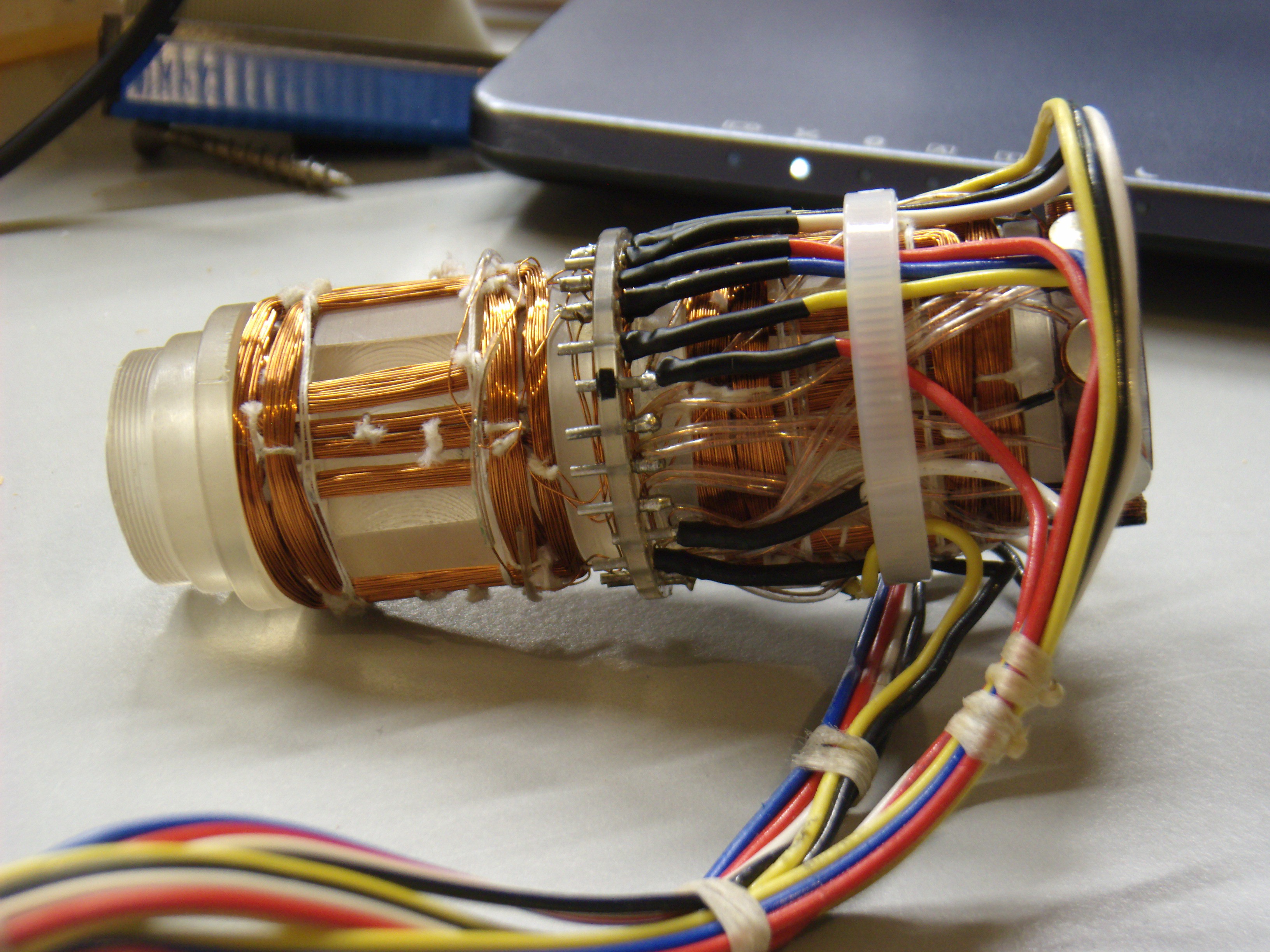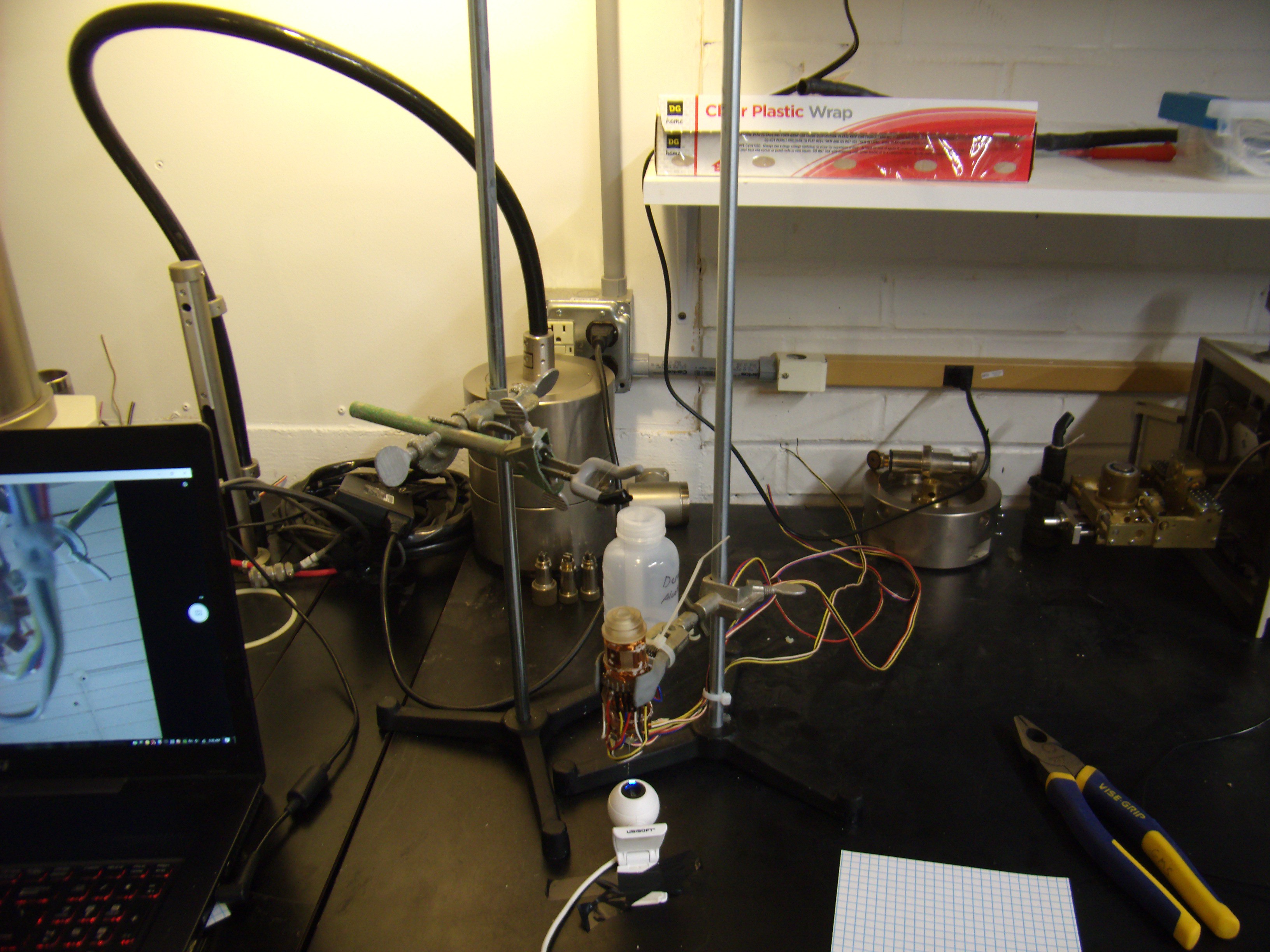Now part that turns this from high-energy flashlight into an SEM; the scanning coils. Once the beam has been through the condensing coils, it passes through the scanning coils. These are saddle shaped coils that guide the beam from in a rectangular raster pattern across the the sample stage.
You'd think there'd be only two coils; one for X and one for Y, but I'm not so lucky. On this particular unit, there's eight scanning coils. The designers must have hated the assemblers, because of all the small heatshrunk connections and tied up with wax string. Whole lot of nope; probably would have destroyed it moving bundles out of the way to see underneath. It's hard to see in the picture below, but with the help of a long strand of hair I stole from another member, a drill bit and webcam, it was a simple matter to just brute force it.
Voila! Drill bit electron beam!

It is exceptionally difficult to create a magnetic system with an acceptable beam without some form of correction. Those eight small coils at the bottom actually have nothing to do with the scanning; they are the stigmator. It serves to correct the misshapen beam, which is pretty much unavoidable. They stretch and squash the beam to help to get as close to a circle-shaped spot to trace across the sample.
In the first photo above, there are actually two sets of scanning coils, one upper and one lower. I really don't have a clear reason why they are separated like this. My gut tells me that it's to reduce the inductance and allow for a faster scan speed, or since it had a fully analog scan system, maybe it had something to do to with helping correct for distortion that couldn't be easily done otherwise, but I don't really know for sure. Are there any SEM engineers out there that can shed some light on this?
 Adam Guilmet
Adam Guilmet

Discussions
Become a Hackaday.io Member
Create an account to leave a comment. Already have an account? Log In.
I'm not around there to check right now, but I re-assembled the column already. I see what you're saying with the opposing scan coils. It seems like they guide the beam in a sort of zig-zag path using the opposing coils. I've got the driver cards, but I'm working on the electron gun right now, so I can get some positive visual feedback on the beam control. I've got an old oscilloscope screen and made a viewport, but, unfortunately, the o-ring on the door looks cracked from old age, so I'm trying to find a replacement for that right now. I can't get the vacuum down below ~100 micron and I narrowed it down to the door, but I'm going to do a helium leak test to be sure.
Are you sure? yes | no
I'm actually working on a similar design problem right now. I bought an rj lee SEM and am building a new column for it and going to control it with a raspberry pi. I just got the scan coil design (or at least an iteration of it) done. It will be interesting to see if it works.
Are you sure? yes | no
can you check if the upper and lower coils are connected in opposing pairs? they probably are so they can be driven with a sing'e amplifier.
Are you sure? yes | no
Dan is also kind of right. There are 8 scan coils there. 4 on the upper and 4 on the lower. It looks like for both horizontal and vertical coils, there are two individual coils that fit one inside the other giving 4 coils at top and bottom. They are probably for low and high mag. it looks like they both have different number of wraps which would make them different in deflection amounts. Also they cover different amounts of the optical axis. They are probably L/R matched at the same ratio so they deflect the beam through the same focal point.
Are you sure? yes | no
Adam,
most high quality objective lenses use scan coils in pairs. They do this so that they can change the beam path while keeping the beam centered through the objective lens. basically the first coil moves the beam off the optical axis in the opposite direction of the scan direction and the second moves it back so that it passes through the center of the objective lens. keeping the beam as close to the center of the lens reduces aberrations. remember that ion optics are poor quality and only approximate good lens properties at the optical axis. that's why so much effort is given to column alignment and uniform energy.
Are you sure? yes | no
That's what I thought of at first, like they have different distances to the the objective focal point, so it would allow the same electronics to drive either coil, or something. But then I came across patent US5254857. Their scan coil assembly looks IDENTICAL and they said "To preserve the large depth of field and other desirable SEM properties we wanted to stay with the double scan coil configuration shown" So I think splitting the coil has to do more with improving image quality than anything. Haven't even really touched the drive electronics yet, though.
Are you sure? yes | no
I think the two sets of scan coils are for different magnification ranges. One set will deflect the beam more than the other. This is awesome, I've never seen a teardown of one of these before. Maybe I'll have a go at building one someday!
Are you sure? yes | no